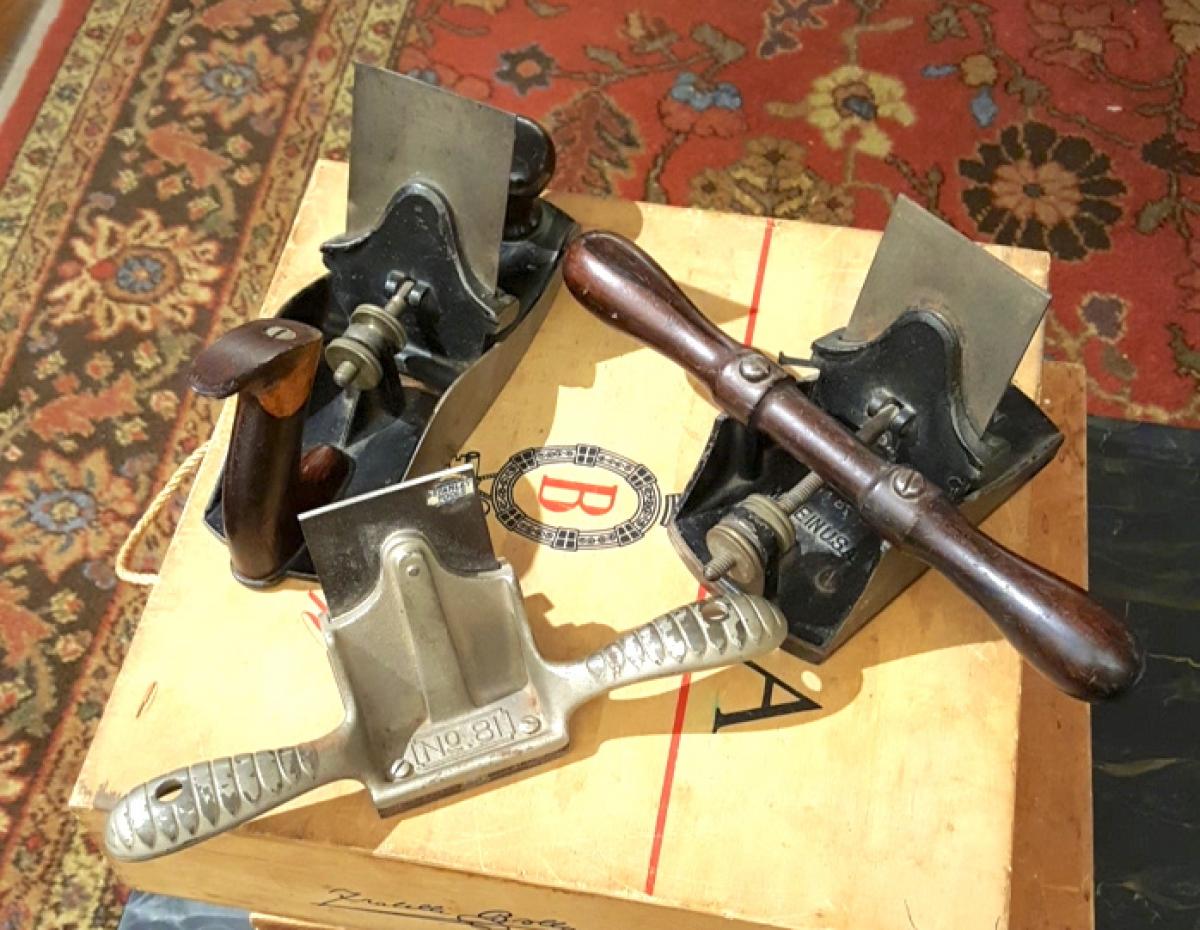 The three Stanley scraper planes in the picture above are part of my tool collection and largely unused. I have two more that didn't make it into the shot - a No. 80 and another No. 12 1/2. The No. 80 was purchased in the 1970's for use but I haven't used it in years. I have no idea where it is. My other 12 1/2 gets occasional use. The three Stanley scraper planes in the picture above are part of my tool collection and largely unused. I have two more that didn't make it into the shot - a No. 80 and another No. 12 1/2. The No. 80 was purchased in the 1970's for use but I haven't used it in years. I have no idea where it is. My other 12 1/2 gets occasional use.
Scraper planes were a lot more popular in the days before sandpaper became ubiquitous. Cabinet scrapers, and scraper planes if you have a lot of scraping to do, are the best way to smooth patchy grain, knots, and other crazy grain features without doing a lot of sanding. Sanding does cover a multitude of sins, and for most people that what one does and that's it. But for many of you wanting a planed finish, scraper planes still have a place in the shop. Instrument makers who need to take off fractions of a shaving very carefully also have a call for scrapers.
But can anyone explain to me why the Stanley Catalogue No. 34 lists eleven different models including a glue scraper? (BTW that glue scraper is very handy and the Kunz version isn't bad either.)
Tool collectors might need every model of every plane. Tool users don't. Or at least I can't figure out why they would.
The interesting question is why Stanley decided to manufacture all these different versions. It certainly makes sense for an non-adjustable version and an adjustable version. But a plain one (No. 12) and a Rosewood bottomed one (12 1/2 in picture) - does it matter?
Of course the reason is that Stanley, like any large company, wanted to have a tool for every segment of the market. You want the lowest cost? Get the No. 80. You want to treat yourself to the top of the line? Get the 12 1/2. A small one handed scraper plane - for smaller work? The 212 fits the bill perfectly. But all these planes do exactly the same thing. The different models exist primarily to satisfy the needs of the manufacturer, not, except in very rare cases, the end user (you).
The same is true of bench planes. They're conveniently numbered from 1 to 8. You might want a smooth plane (3-4), and a long plane (6-8) ( see last blog). Some people also like the "jack" length found in the "5" family. One per group is easy to justify from a user standpoint. After that, I think you enter collector territory. In my particular case, very early on I realized that If I admitted I was a collector I didn't need to sharpen all the tools I owned, just the ones I used. This saved oodles of time and let me keep expanding my collection guilt free.
Picture: Upper left: No. 112. Right: No. 12 1/2. Lower left: No. 81.
Stanley no longer makes the No. 80, but we stock a usable, pretty decent version by Kunz. Most Stanley scraper planes were manufactured in large numbers and are readily available on the used market. We stock replacement blades by Ron Hock for most models which are heavier, better made, and perform better than the original blades.
|
 Joel's Blog
Joel's Blog Built-It Blog
Built-It Blog Video Roundup
Video Roundup Classes & Events
Classes & Events Work Magazine
Work Magazine






















 The three Stanley scraper planes in the picture above are part of my tool collection and largely unused. I have two more that didn't make it into the shot - a No. 80 and another No. 12 1/2. The No. 80 was purchased in the 1970's for use but I haven't used it in years. I have no idea where it is. My other 12 1/2 gets occasional use.
The three Stanley scraper planes in the picture above are part of my tool collection and largely unused. I have two more that didn't make it into the shot - a No. 80 and another No. 12 1/2. The No. 80 was purchased in the 1970's for use but I haven't used it in years. I have no idea where it is. My other 12 1/2 gets occasional use.
I have one set up to be my shooting board plane, one set up with some camber and a big mouth, and one set up as probably closer to a smoothing plane than I should admit (I have a perfectly good smoothing plane, but I still grab this No.5..) It's the only plane I have more than one of, the rest being a block plane, a No. 4, and a No.8.